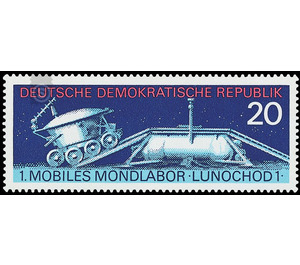First mobile lunar laboratory - Germany / German Democratic Republic 1971 - 20 Pfennig
Theme: Post & Philately
| Country | Germany / German Democratic Republic |
| Issue Date | 1971 |
| Face Value | 20.00 |
| Color | blue |
| Perforation | K 14 |
| Printing Type | Photogravure |
| Stamp Type | Postage stamp |
| Item Type | Stamp |
| Chronological Issue Number | 1401 |
| Chronological Chapter | GER-DDR |
| SID | 791901 |
| In 32 Wishlists | |
1. Mobile Lunar Laboratory "Lunochod 1" The Ministry of Posts and Telecommunications of the German Democratic Republic issues a special stamp with the image of the first mobile lunar laboratory "Lunochod 1". 1. Mobile Lunar Laboratory "Lunochod 1" The Soviet moon mobile has carried out the most varied measurements in several working periods. They range from the study and chemical analysis of lunar soil to the study of sources of radiation far beyond our Milky Way system. Some results will soon have an impact on terrestrial experiments and applications. These include the study of radiations on the lunar soil as well as the investigation of extragalactic radiation sources and the determination of the intensity of radiation outbreaks on the sun. Here is a connection especially to space medicine. During the moonlit nights, the French laser reflector was used to locate the moon, especially the location of Lunochod 1 in the sea of rain. The exact distance of the moon from the earth could be determined with the help of this method with an inaccuracy factor of only a few centimeters. During a working period, two interesting methods of navigation independent of on-board navigation were used: - The method of astronomical navigation over the earth's ground station using panoramic images of the stars. - To apply the method of the so-called shadow compass, whereby the orientation is made according to the length and direction of the shadows throwing bumps on the lunar soil. The leaching of 100g moon material from the fertility sea (Luna 16) and the chemical analysis of the lunar rock by Lunochod 1 in the 100,000 square kilometer rain sea allowed to study the surface matter of the moon from 0 to 35 cm depth. Generally, a distinction can be made between a basaltic, primarily magmatic and a finer, surface-converted particle component. The moon rock is relatively earth-like on the surface of the earth satellite. Among the 70 chemical elements found are: silicon, titanium, aluminum, iron, magnesium, calcium, sodium, potassium, and other chemicals known from Earth. Overall, the study of the moon with vehicles of the type Lunochods is far from complete. This first moon mobile was only a prelude. Already today Soviet scientists announce whole convoys of such lunar vehicles. At the same time, the back side of the Earth satellite will also be explored, with the Earth-Moon-Earth radio link being routed via one or more lunar news satellites. Also of importance will be the use of Lunochods on Mars specially converted for this task. This planet has a similar landscape as the moon with numerous craters. However, there are not the strong temperature differences on it, but there is snow or frost, and certainly there are sandstorms. Lunochod 1: launched on November 10, 1970 with Luna 17, landed on November 17, 1970 soft on the moon. The vehicle was abandoned and started operating the same day. Length of the vehicle: 3.10 m (measured from the front wheel to the rear wheel). Height of the moon mobile: 1.80 m. Mass: 756 kg.


